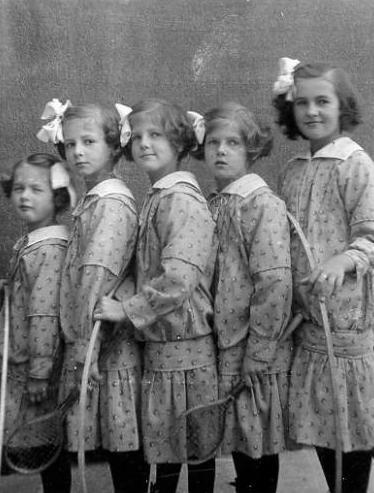
Figure 1.--Here we have a portrait of five unidentified American sisters with hoops. They are all wearing identical dresses. The portrait is undated, but the clothing and mount blook like it was taken about 1910. |


|
American girls wore a range of skirted garments. By far the most important was dresses until the late-20th century.
American girls like girls in other countries wore dresses throughout the 19th and much of the 20th century. We do not know a great deal about dresses at this time. We believe dress styles were largely set in Europe throughout the 19h century. We do not, however, know to what extent American and European dress styles varied. We want to develop information on fashion trends over time. We also want to see how girls' dress styles compared to adult women's styles. This will be very useful in improving our ability to date old photographs, many of which are not dated. Not only did girls wear dresses in the 19th century, but so did younger boys. We notice many different styles of dresses. Girls continued to wear dresses in the 20th century. Only after World War II do we commonly see girls wearing other garments. Of course girls still wear dresses, but for many girls, dresses have become a less important even minor garments, reserved for dress up occassions. Other skirted garments girls wore included skirts and pinafores. Pinafores were widely worn in the 19th and early 20th century. Skirts becane a major style for girls and are still widely worn. Some skirted garments were primarily for boys, including kilts and tunics.
The primary garments worn by girls has been skirted garments. This has been the case for centuries. The primary garment has been the dress, a garment combining the bodice and skirt. I has over time been done in endless variety of styles, decoration, fabric, color and patterns. The dress has been worn in most countries. The dress appears to have evolved from the Western dress appears to have evolved from the robes worn in ancient Greece and Rome. Of course European fashions only reached what is now the United states (17th century). Interestingly, a garment which might be called a dress was wprn by women and girls in many Nirth Americabn tribes. The only other skirted garment of comparable importance is the skirt, usually worn with a blouse. The skirt was generally seen as a more informal alternative to the dress. We are not entirely sure about the chronology of skirt. There are other kirted gsrmnts, two of them (the kilt anbd tunic) are mostly seen as a male garmnt. Other skirted garments have developed over time. We note pinafores appearing (we think in the 18th century). And e we note smocks appearing (19th century). We only note women and girls wearing dresses until fairely recently. Emilia Bloomer invented bloomers a form of baggy pants seen as less restrictive than dresses for outdoor activity (1840s). We note American girls wearing pants, nostly overalls (early-19th century). This was almost entirely limmited to rural areas. After World War I we begin to see girls wearing rompers, shorts and long pants, mosrt for casual;/recreational actibities (1920s). Dresses and skirts continued to be the primsry garments worn by girls. This did not chnge until the 1970s. Girls still wore dresses and skirts, but shoirts and pants becam,e widely worn even at school. Dresses remained, however, not only common, but the standard garment when dressing up.
American girls wore a range of skirted garments. We are developing information on the various skirted garments worn by American girls. Dresses wre of course the standard garment for girls, but skirts were also very imporant. By far the most important was dresses until the late-20th century. American girls like girls in other countries wore dresses throughout the 19th and much of the 20th century. After mid-century girl's clothing became much more diverse. Dresses continued to be standard, but we see girls wearing formerly boys' garments, essentially the reverse of 20th century conventions. We begin to see girls wearing first bloomers and rompers and then shrts in the early-20thcentury, but this was for play at home or for Girl couts and summer camp. After mid-century we begin to see many girls wearing shorts and pants more commonly. Jeans became particularly important. Dresses continued to be widely worn, especially when dressing up. Through the 50s, we see grls wearing dresses and skirts to school, but in the 60s we see girls neginning to wear shorts and long pants to school. At forst this was primry chool girl, bjut by the 70s we see girls in seconday chool wearing pants, espeially jeans. This was hen we begin to see designer jeans. At firsr schools had rules. but eventually it was left to the children and their parents. Pinafores were commonly wrn y grls in the 19th and raely-20th century. Somocks were, however, not very common.American girls did not wear two skirted garmnts, kilts and tunics. These were boys' garments.
Color is a difficult subject to assess because until thec mid-20th cebntury almost all photiography was black and white. And photography is our major source of information. Other sources of infornmation become available in the 20th centyury such as magazines, but the 19th centuyry us largely nkack and white world. We have paintings which provide some information, but the number of paintings is very small compared to the number of photographs. .
Patterned or print fabric are a relativerly modern development. Earlier patterns could be inroduced as part pf the weaving process. Thhe best known fabric is plaids. The Industrial Revolution most immediately led to calico prints. Here engraved rollers and cylinders were used to create patterns. Most of this work was done in Europe with Anerican companies gradually adopting the techniques and processes. Dyehouses known as printworks opened in Switzerland, Germany and England adopting steadily improving processes. It was, however, the French who excelled textile print fashions. One fashionn hitorian writes, "... it was undoubtedly the French that led the way in the textile printing craft and enriched it with an undeniably artistic quality that many attempted to replicate. In America pits only appeared in the late-19th century and were primarily a 20th cenury phenomenon as a result of major technical advances. Patterned skirted garments were generally worn by girls. Patterns were not exclusively for girls, but the vast majority of patterned skirted garments were worn by girls. These were commonly called prints. The dresses the girls here are wearing are an excellent example, but we can't make out the actual pattern (figure 1). Girls wore a wide variety of patterns. We see polkadots, flowers, plants, and much more were popular choices. Two patterns were commonly worn by both boys and girls, stripes and plaid. These were one of the few patterns commonly worn by boys, but were popular with girls as well, especially plaid. During the 19th century, the brughter plaids seem more commoin for the girls than the boys. Strangely, in the 20th centuty, plaid became popular for boy's shirts in the 20th century. Rather inexplicably plaid was not popular for girls' blouses, but became very popular for girls' skirts.
Girls skirt and dress hem lines were fairly stable in the 19th century, but varied substantially in the 20th century. Women wore long dresses throughout the 19th century. Girls hem lines were more varied. Dresses and skirts followed the same hem line trends. We notice long dresses in the early-19th century, but shorter drsses worn with long pantalettes. The actual length of girls dresses varoes with ageThe basic length seems to have settled in at mid-calf after mid-century, but his is just a preliminary asessment. We assume that boys wearing dresses and kilted outfits followed the same conventions, but this needs to be confirmed. We have seen younger boys with longer hem lines, but this may be mother buying outfits that will last awhile. . This is an interesting topic because it may provide one more tool to help us date undated images. Girls began wearing pants in the 20th century which added new garments to the hem-line topic.
Navigate the Girls Historical Clothing Web Site:
[Return to the Main American girls garment page]
[Return to the Main American girls page]
[Return to the Main girls country page]
[Return to the Main girls page]
[About Us]
[Activities]
[Biographies]
[Chronology]
[Color]
[Countries]
[Difficult images] >> combine w/ photo interprtation
[Fashion]
[Families]
[Garments]
[Gender conventions]
[Hair]
[Literature]
[Photo intrpretation]
[School]
[Sisters]
[Return to the Historical Girls Clothing Home Site]
